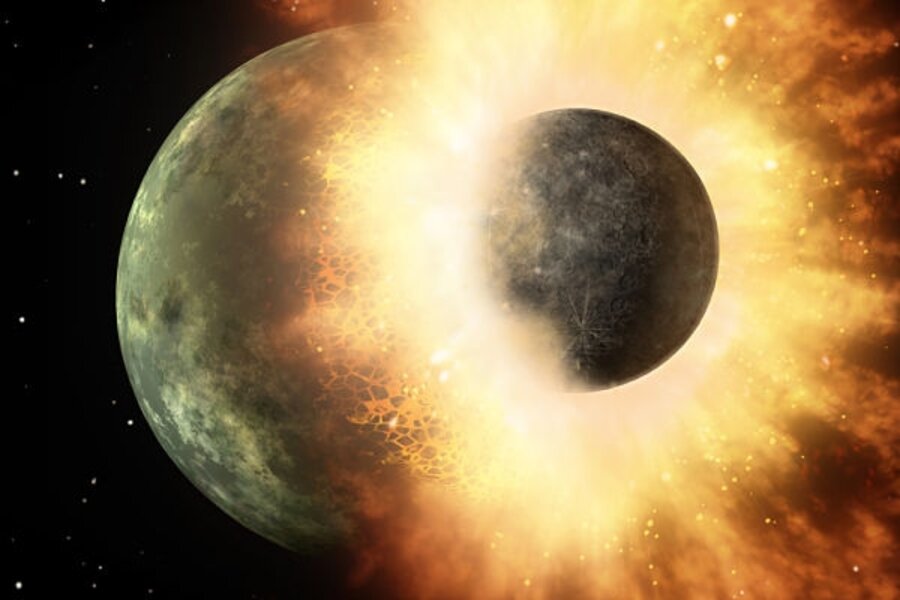Astronomers spot planetary wreckage around distant star
Loading...
It must have been one bodacious crunch -- akin to the moon and Mercury racing to occupy the same spot at more than 22,300 miles an hour.
The story of a collision between nascent planets is written in a disk of dust around a star 100 light-years away, according to an international team of astronomers formally reporting the results in an upcoming issue of the Astrophysical Journal. A plain-English version appears here.
The dust surrounds a 12-million-year-old star labeled HD172555. The dust disk shouldn't be there. It should long since have clumped into larger objects that form the building blocks of planets.
But the dust is there. Its make-up, revealed via NASA's Spitzer Space Telescope, suggests that it formed in a collision between two so-called planetesimals. The smash-up took place within the last 100,000 years, and perhaps as recently as 1,000 years ago.Among the minerals the team identified in the disk's spectra: obsidian and tektites, glassy rocks that forms at very high temperatures. Tektites in particular form during a collision. Rock melted by the heat of impact hurtles from the impact site, cooling as it travels.
The observations recorded vast amounts of silicon-oxide gas, which forms when silicate-bearing rocks vaporize. The scientists also detected large amounts of cold, sizable dust. But the smoking gun was the presence of unusually large amounts of warm, fine dust, opening a unique window on the dust's chemical make-up.
The relative abundance of each led them to conclude that an object at least as large as the moon was the loser plano-a-plano with an object at least as large as Mercury.
"In any system that's older than 10 million years, when we see warm dust" returning remarkably detailed information about its chemical composition, "it tells us that something extraordinary has happened," says Carey Lisse, a senior research scientist at the Johns Hopkins University's Applied Physics Laboratory in Laurel, Md.
Why? He explained during a phone chat that above a certain size, say, 100 microns (100 millionths of an inch), dust grains are essentially opaque. They may re-radiate light they receive from a star they orbit. But they do it equally well across all wavelengths. So astronomers have a hard time picking up changes in the spectra they look for that uniquely signal each chemical compound in the dust.
But if the grains are thin enough, say around 1 micron, they in effect become transparent. Light can interact with the mineral crystals in the grains, revealing their chemical composition.
In essence, Lisse concludes, something remarkable must have happened to pulverize material to the point where it would reveal its chemical fingerprints in a solar system where dust that small, in amounts large enough for Spitzer to detect, should have disappeared a long time ago.
The ability to glean this information traces its roots at least in part to NASA's Deep Impact mission to study comet Tempel 1, another project Lisse took part in.
The highlight of the mission came when the spacecraft release an impactor to collide with the comet. The Spitzer Space Telescope was one of the tools scientists used to track the material the impact kicked up. And it showed researchers what the spectra from warm dust from a collision would look like, Lisse says. The spectra went from fairly boring to stunningly detailed in an instant.
To be sure, you don't have to look beyond our solar system to find plenty of evidence that planets absorb mighty whacks as they evolve. Mercury's current surface is thought to represent lower layers of what originally was a heftier planet. Venus spins backward compared with other planets. Mars is more heavily cratered in its southern hemisphere than in its northern hemisphere. Uranus got knocked on its side -- spinning almost as if it had an east pole and west pole, rather than a north pole and south pole.
The detritus from HD172555's blast from the not-so-distant-past, however, is giving astronomers a unique opportunity to monitor such collisions at a far earlier stage of the clean-up process.
And it's giving scientists the "look" they can hunt for around other young stars as they try to gather data from different periods along a time line from "ooof" to "ahhhh."





